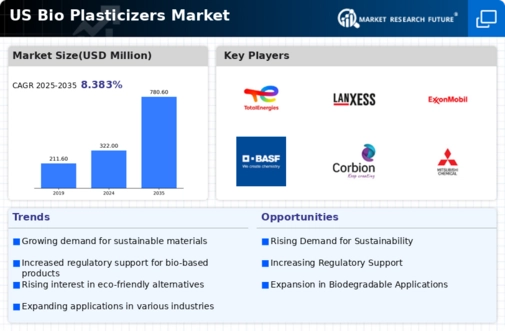The US Bio Plasticizers Market has been experiencing significant growth driven by increasing demand for sustainable and eco-friendly alternatives to traditional plasticizers. Various industries including packaging, automotive, and construction are actively seeking bio-based materials to meet both regulatory requirements and consumer preferences for greener products. Competitive insights reveal a dynamic landscape where companies are focusing on innovation, product development, and strategic partnerships to enhance their market presence. The shift towards bio plasticizers is not only aimed at improving sustainability but also involves meeting performance criteria that can match or exceed conventional products.
With the growing emphasis on reducing carbon footprints and enhancing the circular economy, players in the market are positioning themselves to leverage these trends while addressing competitive challenges.TotalEnergies has established a notable presence in the US Bio Plasticizers Market, focusing on harnessing renewable feedstocks and sustainable practices to produce bio-based plasticizers. The company’s strengths lie in its commitment to sustainability, extensive research and development capabilities, and its integration across the energy and chemical sectors. This integration allows TotalEnergies to optimize its supply chain and ensure the availability of quality raw materials essential for its bio plasticizer offerings.
The company has made significant investments in technology to improve the performance and efficiency of its products, helping it carve out a competitive edge in the market. Moreover, TotalEnergies is actively engaging in collaborations and partnerships with other key players and stakeholders to further enhance its market position and broaden its product portfolio in line with the evolving needs of its customers.Lanxess also plays a pivotal role in the US Bio Plasticizers Market, focusing on the production of high-performance, bio-based plasticizers that cater to various applications.
The company is recognized for its innovative solutions that emphasize sustainability and performance, offering products such as esters derived from renewable sources. With a robust market presence, Lanxess has solidified its reputation as a leader in specialty chemicals, allowing it to respond effectively to market demands and regulatory challenges. The company continually invests in research and development to expand its range of bio plasticizers, ensuring they meet industry standards and customer expectations. Recent mergers and acquisitions have further strengthened Lanxess's capabilities in the bioplastics sector, enabling better access to technological advancements and expanding its ability to innovate.
Through these strategies, Lanxess is positioned to maintain its competitive advantage in the evolving landscape of the US Bio Plasticizers Market.























Leave a Comment